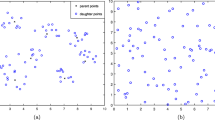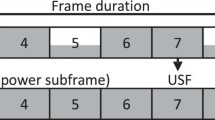Abstract
In this paper, the uplink and downlink performance of a two-tier heterogeneous network (HetNet) with range expansion (RE) is analyzed. Different from previous works, base stations (BSs) are modeled as a spatial Poisson point process. This model can not only capture the irregularity of the BS deployment but also lead to closed form expressions. With the analytical results, the impacts of several key parameters on the coverage and throughput performance are investigated. Our results justifies the effectiveness of RE and Pico deployment. Based on our analyses, certain attention should be made on the RE design to balance the uplink and downlink performance. Our analyses are corroborated by simulations and can thus serve as a flexible and quick guidance for system design without complicated and time-consuming system-level platform construction and simulation.
Similar content being viewed by others
References
Khandekar A, Bhushan N, Tingfang J, et al. LTE advanced: heterogeneous networks. In: Proceedings of 2010 European Wireless Conference (EW), Lucca, 2010. 978–982
Shu F, Berber S, Wang D M, et al. ML integer frequency offset estimation for OFDM systems with null subcarriers: estimation range and pilot design. Sci China Inf Sci, 2010, 53: 2567–2575
Cui Q M, Huang X Q, Luo B, et al. Capacity analysis and optimal power allocation for coordinated transmission in MIMO-OFDM systems. Sci China Inf Sci, 2012, 55: 1372–1387
Landström S, Furuskär A, Johansson K, et al. Heterogeneous networks increasing cellular capacity. Ericsson Rev Technol, 2011: 4
Cao Y, Xia H L, Feng C. Evaluation of diverse cell range expansion strategies applying CoMP in heterogeneous network. In: Proceedings of IEEE 24th International Symposium on Personal, Indoor and Mobile Radio Communications (PIMRC), London, 2013. 1962–1966
Okino K, Nakayama T, Yamazaki C, et al. Pico cell range expansion with interference mitigation toward LTE-Advanced heterogeneous networks. In: Proceedings of IEEE International Conference on Communications (ICC), Kyoto, 2011. 1–5
Wang Y, Tao R, Li B Z. Using the multi-living agent concept to investigate complex information systems. Sci China Ser F-Inf Sci, 2009, 52: 1–17
Dhillon H S, Ganti R K, Baccelli F, et al. Modeling and analysis of K-Tier downlink heterogeneous cellular networks. IEEE J Sel Area Comm, 2012, 30: 550–560
Jo H S, Sang Y J, Xia P, et al. Heterogeneous cellular networks with flexible cell association: a comprehensive downlink SINR analysis. IEEE Trans Wirel Commun, 2012, 11: 3484–3495
Andrews J G, Baccelli F, Ganti R K. A tractable approach to coverage and rate in cellular networks. IEEE Trans Commun, 2011, 59: 3122–3134
Novlan T D, Ganti R K, Ghosh A, et al. Analytical evaluation of fractional frequency reuse for OFDMA cellular networks. IEEE Trans Wirel Commun, 2011, 10: 4294–4350
Wang H, Ma S, Ng T, et al. A general analytical approach for opportunistic cooperative systems with spatially random relays. IEEE Trans Wirel Commun, 2011, 10: 4122–4129
Wang H, Ma S and Ng T. On performance of cooperative communications system with spatially random relays. IEEE Trans Commun, 2011, 59: 1190–1199
Guo A, Haenggi M. Spatial stochastic models and metrics for the structure of base stations in cellular networks. IEEE Trans Wirel Commun, 2013, 12: 5800–5812
Goldsmith A. Wireless Communications. Cambridge: Cambridge Press, 2005
Wang D, Ji C, Sun S, et al. Spectral efficiency of multi-cell multi-user DAS with pilot contamination. In: Proceedings of IEEE Wireless Communications and Networking Conference (WCNC), Shanghai, 2013. 3208–3212
Baccelli F, Błaszczyszyn B, Mühlethaler P. Stochastic analysis of spacial and opportunistic aloha. IEEE J Sel Area Comm, 2009, 27: 1105–1119
Stoyan D, Kendall W, Mecke J, et al. Stochastic Geometry and its Applications. Chichester: Wiley, 1995
Gradshteyn I S, Ryzhik I M. Tables of Integrals, Series, and Products. San Diego: Academic Press, 2007
You X, Wang D, Zhu P, et al. Cell edge performance of cellular mobile systems. IEEE J Sel Area Comm, 2011, 29: 1139–1150
Author information
Authors and Affiliations
Corresponding author
Electronic supplementary material
Rights and permissions
About this article
Cite this article
Fei, Z., Ding, H., Xing, C. et al. Performance analysis for range expansion in heterogeneous networks. Sci. China Inf. Sci. 57, 1–10 (2014). https://doi.org/10.1007/s11432-014-5071-2
Received:
Accepted:
Published:
Issue Date:
DOI: https://doi.org/10.1007/s11432-014-5071-2




